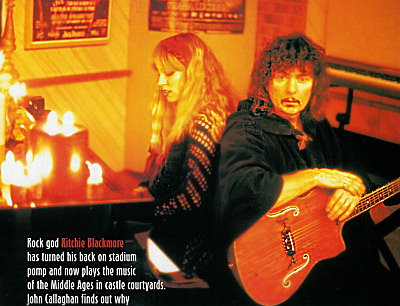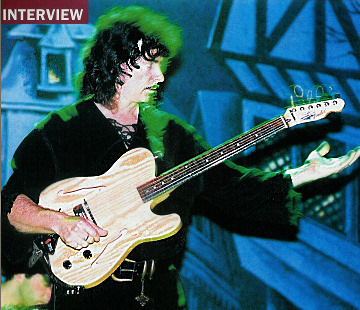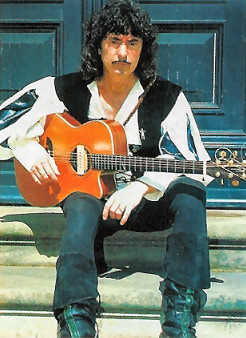|
Ritchie Blackmore FROM RAINBOW TO THE RENAISSANCE RENAISSANCE MAN  Rock god Ritchie Blackmore has turned his back on stadium pomp and now plays the music of the Middle Ages in castle courtyards. John Callaghan finds out why.
Rock god Ritchie Blackmore has turned his back on stadium pomp and now plays the music of the Middle Ages in castle courtyards. John Callaghan finds out why.At the age of nine, Ritchie Blackmore heard that 16th century pop fave Greensleeves for the first time. As we all know, the young Blackmore went on to become one of the most lauded rock guitarists of all time - during his stints with Deep Purple and Rainbow - but this love of Renaissance music never left him. In fact, he frequently spent his downtime during the mammoth arena tours of the '70s strumming his acoustic along to these ancient melodies. 'I always thought at that point that it would remain a private thing,' recalls Blackmore. 'I also thought that Renaissance music was too rigid and purist to do anything with. But as time passed I came up with a few ideas that I thought would open the doors for people who had never really heard this kind of music, except in old films.' However, it was only when he met American singer Candice Night, who shared a similar passion for the music, that Blackmore realise this labour of love could now be presented in the right way for public consumption. 'We knew that we weren't going to compete with the likes of Britney Spears by playing Renaissance music! Promoters and managers were quite nervous about us, wondering what the hell I was doing. But I adore this music and you've got to follow your heart... you can't do something just because it's a good business decision.' The duo, under the moniker Blackmore's Night, are now three albums into their voyage. Their latest offering, Fires At Midnight, is an enchanting collection of melodies and soundscapes that will leave even the hardest cynics with warm, glowing cockles. When the subject of how the duo have developed since their first album, 1997's Shadow Of The Moon, Blackmore sighs in resignation, before claiming that it's something that he never thinks about... 'I just play guitar and see what happens,' he insists. 'This is just another record we've made that we hope people like. In fact, the only development this time around was that we got a producer in. I always have this dilemma as to whether to keep things really organic and pure, just Candice's voice and my acoustic guitar, or to have a more produced sound with more instrumentation to entice people in. For Fires At Midnight, we decided to go with the latter route to reach a broader audience, commercialise things a bit - without compromising anything.' As proud as he is of Blackmore's Night, you'll have to wait for hell to get right chilly before the former Rainbow man will ever boast of his own guitar playing achievements on record. 'I always think more of the songs. I don't I ever get across how I really play on record,' he winces. 'Sometimes I get this terrible attitude in the studio where I try not to make mistakes, whereas live I'm not so worried and cut loose a bit more.' Given this self-doubt, it may come as no surprise to hear that Blackmore intends to put out a live album next something he feels he can do now with the band he has now. Getting the right bunch of like-minded musicians was a struggle, though, and Blackmore recalls how many of the hopefuls who came down to try out played as if 'they were auditioning for Deep Purple or Rainbow, which irritated me no end, because what we're doing is nothing like that'.  If you want to check out the Blackmore's Night experience yourself, then forget about enormodomes, or even small clubs. The 'Night prefer to peddle their 16th century-based wares in the more appropriate surroundings of castles and courtyards around the globe.
If you want to check out the Blackmore's Night experience yourself, then forget about enormodomes, or even small clubs. The 'Night prefer to peddle their 16th century-based wares in the more appropriate surroundings of castles and courtyards around the globe.'I always felt envious of people who played guitar seminars to 20 people - that intimate, more casual setting. I've played a lot of arenas where you're almost obliged to do that pomp rock thing of running around, shaking your fists and breaking your guitars. I would never have played acoustic in those days, because everyone would have been shouting "Get on with it! Play some rock'n'roll!",' he laughs. 'But with shows from 200-2,000 now, we can relax more. Arenas are dark and smoky, whereas playing castles and courtyards in good weather is a magical experience.' People have responded in almost fanatical fashion to these Blackmore's Night extravaganzas. The uniqueness of their sound in the new millennium has led to devotees travelling around the world to see them, often dressing up in medieval garb to add further authenticity to the experience. 'It's got out of control!' jokes Blackmore. 'It does make it a great party atmosphere and makes the audience just as big a part of it as the musicians, which I love. It keeps the egos off the stage. I'm so thankful people are listening to it. It would be upsetting if nobody did, because this music is so exciting to play. Sometimes we play for over three hours, whereas in Rainbow we were lucky if we could manage an hour and 15 minutes.' Though his 'Purple and Rainbow days. are far behind him, Blackmore hasn't completely ditched his heavier roots, a number of tracks on Fires At Midnight feature his unique electric guitar tones - and 20 per cent of the live set is him plugged into an amp, playing more rockbased songs. 'I'm a rock player and that probably will always come through,' he admits. 'I like to express myself on electric lead guitar, because it's more of a freeform thing. The acoustic guitar and Renaissance music is a much more rigid setup. Also, on songs like Fires At Midnight, going into electric guitar makes things much more one-dimensional.' This switching from the electric to the acoustic has caused havoc with his nails; having grown them to play fingerstyle on his acoustic, by the first week of every tour sees them all broken as a result of playing the heavier songs. 'I've tried fake nails and they're great for the first song, but after that they bend up so I catch the string between the false nail and the real one, and I miss strings. 'I also had a few problems when I went over to playing the acoustic guitar. The thing that really does you in is just holding down the basic chords and strumming harder, rather than just running up and down the fretboard in B minor as you do on electric.' B minor is still a particular favourite chord and key for Blackmore, due to the number of open notes on offer, as well as its mediaeval timbre. 'A minor is also used a lot for our music, because it's a very good key for Candice to sing in. It used to be G back in the rock days, not E like most other rock bands.' Writing and playing with a female vocalist, admits Blackrore, has led to a greater appreciation of these kind of niceties when composing. 'When I was writing before for Ian Gillan and Ronnie Dio I would just tell them "Here's the riff and here's the key it's in - best of luck!" Writing music with Candice and studying this type of music has made me consider these things more,' he recalls Such scholarly work has also led Blackmore to believe that music from the 1500s isn't that dissimilar to modern-day rock. 'Your technique does have to be very exact, whereas you can get away with sloppiness in rock, but the melodies are often based on parallel harmonies, but in fourths rather than fifths. 'When I was learning the guitar at 15 I used a lot more jazzy structures and I was a lot more complicated, but I've cut that out over the years and concentrated on simplicity,' he declares. 'For example, the riff to Smoke On The Water is something I imagine could easily be played in Renaissance style.' Blackmore does think a few of his Rainbow songs are also ripe for being reinterpreted. However, on Fires At Midnight he chose to give the olde worlde treatment to Bob Dylan's classic The Times They Are A Changin' 'I've always loved Bob Dylan and we used to play the song for friends - almost as a novelty thing, really. As time passed we thought we could add something to it; to this day I don't know the chords of the way Dylan plays it! 'But that's the great thing about doing what I'm doing now,' he concludes. 'Candice and I can do anything we want; we can play our favourite songs exactly the way we want and not have to worry about the expectations of the music industry. Free at last. MINSTREL'S GALLERY  Blackmore used to rely solely on Alvarez acoustics for both live and studio work - and you can still hear their warm, lush tones all over Fires At Midnight. However, these days the Alvarez has to compete with a number of Lakewoods for the man's affection. 'The one you hear on Praetorious (Courante) is a smaller guitar, the body's only 2.5" deep and it has a thin neck. That and the f-holes give it a much brighter tone. It sounds like a cross between a lute and a guitar.
Blackmore used to rely solely on Alvarez acoustics for both live and studio work - and you can still hear their warm, lush tones all over Fires At Midnight. However, these days the Alvarez has to compete with a number of Lakewoods for the man's affection. 'The one you hear on Praetorious (Courante) is a smaller guitar, the body's only 2.5" deep and it has a thin neck. That and the f-holes give it a much brighter tone. It sounds like a cross between a lute and a guitar.`Unfortunately it feeds back too much onstage, so I often use a larger model, which resonates more and has more warmth. And I always like to leave my strings on for a week or so before recording. When I started playing acoustics I really wanted that zingy, incredibly bright sound that a lot of acoustic guitarists have, so I always used fresh strings. But you can overdose on that really quickly and now I prefer a more woody, low-end sound.' Committing acoustic parts to tape is a simple guitar-and-mic operation in Blackmore's eyes. Although his Trace Elliot and Fender Acoustasonic combos do a sterling job for gigs, he feels all acoustic amps 'electrify' the sound of any soundholebearing instruments in the studio. When Blackmore goes electric, he's still never found anything to match the range of expression his Strat and stalwart Engel 50W have provided over the years. 'I still even use the old Aiwa tape recorder that I've for years as a preamp. It gives off this very flat sustain that doesn't sound contrived, like pedals seem to. I've tried to get an exact replica built but I can't seem to get quite the same qualities from anything else.' A collector of weird and wonderful instruments, Blackmore also cranks out the hurdy gurdy and bangs the Renaissance drum on Fires At Midnight. He doesn't consider himself to be anything other than a guitar player, though. 'I play mandolin on the album, but I not only play it like a guitar player, but also tune it like one - in fourths, not fifths. 'It's the terrain I know. Studying and playing guitar is hard enough without have to take on different tunings and techniques!' John Callaghan, Guitar Magazine, U.K. February 2002 |